
Concept explainers
Acid-catalyzed hydrolysis of a nitrile to give a
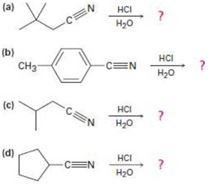
a)

Interpretation:
The products of the reaction, the acid-catalyzed nitrile hydrolysis, along with all the steps involved using curved arrows to represent electron flow in each step, is to be given.
Concept introduction:
The acid protonates the nitrogen of the nitrile group initially. The nucleophilic attack by water and subsequent proton transfer will yield an intermediate. Another nucleophilic attack by water on the intermediate and yet another proton transfer produces another intermediate. The intermediate loses ammonia to produce the protonated acid which deprotonates to yield the acid.
To give:
The products of the reaction, the acid-catalyzed nitrile hydrolysis, along with all the steps involved using curved arrows to represent electron flow in each step.
Answer to Problem 25MP
The products of the reaction are ammonia and 2,2-dimethylbutanoic acid.
The mechanism of the reaction is given below.
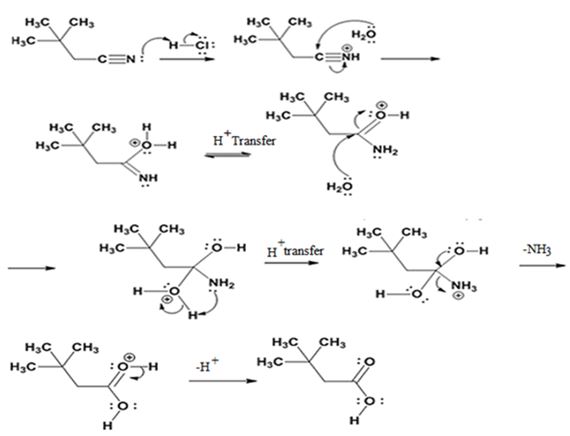
Explanation of Solution
In the first step, 2,2-dimethylbutane nitrile is protonated by HCl. In the next step, the nucleophilic attack of water on the protonated nitrile occurs and the accompanying proton transfer yields a protonated aminoketone. Another nucleophilic attack on the carbonyl carbon of the protonated aminoketone in the next step and the subsequent proton transfer yields a protonated diol intermediate which eliminates ammonia and a proton in the subsequent steps to yield 2,2-dimethylbutanoic acid.
The products of the reaction are ammonia and 2,2-dimethylbutanoic acid.
The mechanism of the reaction is given below.

b)

Interpretation:
The products of the reaction, the acid-catalyzed nitrile hydrolysis, along with all the steps involved using curved arrows to represent electron flow in each step, is to be given.
Concept introduction:
The acid protonates the nitrogen of the nitrile group initially. The nucleophilic attack by water and subsequent proton transfer will yield an intermediate. Another nucleophilic attack by water on the intermediate and yet another proton transfer produces another intermediate. The intermediate loses ammonia to produce the protonated acid which deprotonates to yield the acid.
To give:
The products of the reaction, the acid-catalyzed nitrile hydrolysis, along with all the steps involved using curved arrows to represent electron flow in each step.
Answer to Problem 25MP
The products of the reaction are ammonia and p-methylbenzoic acid.
The mechanism of the reaction is given below.
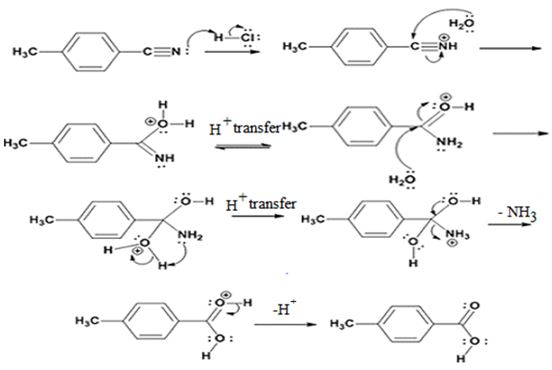
Explanation of Solution
In the first step, p-methylbenzonitrile is protonated by HCl. In the next step, the nucleophilic attack of water on the protonated nitrile occurs and the accompanying proton transfer yields a protonated aminoketone. Another nucleophilic attack on the carbonyl carbon of the protonated aminoketone in the next step and the subsequent proton transfer yields a protonated diol intermediate which eliminates ammonia and a proton in the subsequent steps to yield p-methylbenzoic acid.
The products of the reaction are ammonia and p-methylbenzoic acid.
The mechanism of the reaction is given below.

c)

Interpretation:
The products of the reaction, the acid-catalyzed nitrile hydrolysis, along with all the steps involved using curved arrows to represent electron flow in each step, is to be given.
Concept introduction:
The acid protonates the nitrogen of the nitrile group initially. The nucleophilic attack by water and subsequent proton transfer will yield an intermediate. Another nucleophilic attack by water on the intermediate and yet another proton transfer produces another intermediate. The intermediate loses ammonia to produce the protonated acid which deprotonates to yield the acid.
To give:
The products of the reaction, the acid-catalyzed nitrile hydrolysis, along with all the steps involved using curved arrows to represent electron flow in each step.
Answer to Problem 25MP
The products of the reaction are ammonia and 2-methylbutanoic acid.
The mechanism of the reaction is given below.
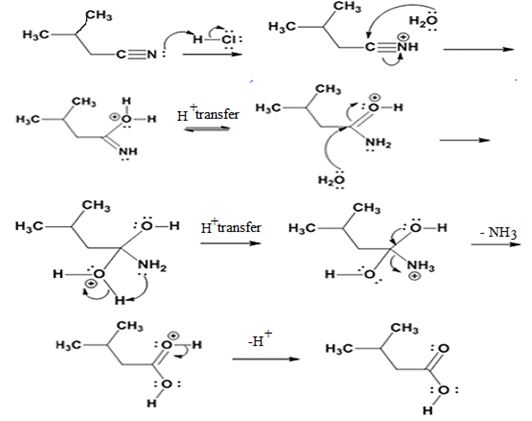
Explanation of Solution
In the first step, 2-methylbutane nitrile is protonated by HCl. In the next step, the nucleophilic attack of water on the protonated nitrile occurs and the accompanying proton transfer yields a protonated aminoketone. Another nucleophilic attack on the carbonyl carbon of the protonated aminoketone in the next step and the subsequent proton transfer yields a protonated diol intermediate which eliminates ammonia and a proton in the subsequent steps to yield 2-methylbutanoic acid.
The products of the reaction are ammonia and 2-methylbutanoic acid.
The mechanism of the reaction is given below.

d)

Interpretation:
The products of the reaction, the acid-catalyzed nitrile hydrolysis, along with all the steps involved using curved arrows to represent electron flow in each step, is to be given.
Concept introduction:
The acid protonates the nitrogen of the nitrile group initially. The nucleophilic attack by water and subsequent proton transfer will yield an intermediate. Another nucleophilic attack by water on the intermediate and yet another proton transfer produces another intermediate. The intermediate loses ammonia to produce the protonated acid which deprotonates to yield the acid.
To give:
The products of the reaction, the acid-catalyzed nitrile hydrolysis, along with all the steps involved using curved arrows to represent electron flow in each step.
Answer to Problem 25MP
The products of the reaction are ammonia and cyclopentanecarboxylic acid.
The mechanism of the reaction is given below.
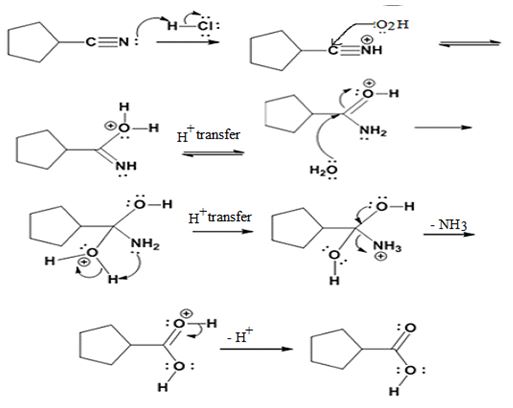
Explanation of Solution
In the first step, cyclopentanenitrile is protonated by HCl. In the next step, the nucleophilic attack of water on the protonated nitrile occurs and the accompanying proton transfer yields a protonated aminoketone. Another nucleophilic attack on the carbonyl carbon of the protonated ketone in the next step and the subsequent proton transfer yields a protonated aminodiol intermediate which eliminates ammonia and a proton in the subsequent steps to yield cyclopentanecarboxylic acid.
The products of the reaction are ammonia and cyclopentanecarboxylic acid.
The mechanism of the reaction is given below.

Want to see more full solutions like this?
Chapter 20 Solutions
Bundle: Organic Chemistry, 9th, Loose-Leaf + OWLv2, 4 terms (24 months) Printed Access Card
- 9. Write Me product as well as the reaction Mechanism For each of the Following Vanctions +H₂504 4.50+ T C. +212 Fellz 237 b. Praw the potential energy Diagrams For each OF Mese Rauctions and account For any differences that appear in the two potential Puergy Diagrams which of here two reactions 19 Found to be Reversable, Rationalice your answer based upon the venation mechanisms and the potential energy diagrams.arrow_forward9. Write Me product as well as the reaction Mechanism For each of the Following Veritious +H2504 4.50+ + 1/₂ Felly ◎+ 7 b. Praw he potential energy Diagrams For each OF Mese Ronctions and account for any differences that appeak in the two potential Puergy Diagramsarrow_forwardDraw the major product of this reaction. Ignore inorganic byproducts. Incorrect, 3 attempts remaining 1. excess Br2, NaOH 2. neutralizing workup Qarrow_forward
- Given the electrode Pt | Ag | Ag+ (aq), describe it.arrow_forwardAt 25°C, the reaction Zn2+ + 2e ⇄ Zn has a normal equilibrium potential versus the saturated calomel electrode of -1.0048 V. Determine the normal equilibrium potential of Zn versus the hydrogen electrode.Data: The calomel electrode potential is E° = 0.2420 V versus the normal hydrogen electrode.arrow_forwardElectrochemistry. State the difference between E and E0.arrow_forward
- In an electrolytic cell, the positive pole is always assumed to be on the right side of the battery notation. Is that correct?arrow_forwardIn an electrolytic cell, the positive pole is always assumed to be on the right side of the battery. Is that correct?arrow_forwardCalculate the free energy of formation of 1 mol of Cu in cells where the electrolyte is 1 mol dm-3 Cu2+ in sulfate solution, pH 0. E° for the Cu2+/Cu pair in this medium is +142 mV versus ENH.Assume the anodic reaction is oxygen evolution.Data: EH2 = -0.059 pH (V) and EO2 = 1.230 - 0.059 pH (V); 2.3RT/F = 0.059 Varrow_forward
- If the normal potential for the Fe(III)/Fe(II) pair in acid at zero pH is 524 mV Hg/Hg2Cl2 . The potential of the saturated calomel reference electrode is +246 mV versus the NHE. Calculate E0 vs NHE.arrow_forwardGiven the galvanic cell whose scheme is: (-) Zn/Zn2+ ⋮⋮ Ag+/Ag (+). If we know the normal potentials E°(Zn2+/Zn) = -0.76V and E°(Ag+/Ag) = 0.799 V. Indicate the electrodes that are the anode and the cathode and calculate the E0battery.arrow_forwardIndicate the functions that salt bridges have in batteries.arrow_forward

 Organic ChemistryChemistryISBN:9781305580350Author:William H. Brown, Brent L. Iverson, Eric Anslyn, Christopher S. FootePublisher:Cengage Learning
Organic ChemistryChemistryISBN:9781305580350Author:William H. Brown, Brent L. Iverson, Eric Anslyn, Christopher S. FootePublisher:Cengage Learning Introduction to General, Organic and BiochemistryChemistryISBN:9781285869759Author:Frederick A. Bettelheim, William H. Brown, Mary K. Campbell, Shawn O. Farrell, Omar TorresPublisher:Cengage Learning
Introduction to General, Organic and BiochemistryChemistryISBN:9781285869759Author:Frederick A. Bettelheim, William H. Brown, Mary K. Campbell, Shawn O. Farrell, Omar TorresPublisher:Cengage Learning


